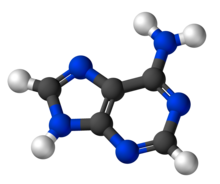Adenine
Adenine is one of the four nitrogenous bases that are part of nucleic acids (DNA and RNA) and in the genetic code it is represented by the letter A. The other three bases are guanine, cytosine, and thymine in DNA. Adenine always pairs with thymine in DNA.
It forms adenosine (RNA) and deoxyadenosine (DNA) nucleotides, and adenylate (DNA) and deoxyadenosine (DNA) nucleotides. In the old literature, adenine was once called vitamin B4; however, today it is not considered a true vitamin.
Its formula is C
5H
5N
5. It is a purine derivative (it is a purine base) in which a hydrogen has been replaced by an amino group (NH
2):
Like guanine, cytosine, thymine and uracil (all nitrogenous bases), it forms part of the nucleotides that make up the long chains of nucleic acids; each nucleotide is made up of a phosphate group, a five-carbon sugar (ribose or deoxyribose) and a nitrogenous base of those already mentioned. In the 'twisted ladder' double helix structure of deoxyribonucleic acid (DNA), each base couples with another specific base, forming the 'rungs' of the ladder. The union of these bases occurs by chemical affinity, so that in DNA, adenine always binds to thymine. In nucleotide sequences, adenine is represented by the letter A.
It is also part of the adenosine triphosphate molecule, which is the main source of energy at the cellular level, and is present in many natural substances such as beets, tea and urine.
Adenine, along with thymine, was discovered in 1885 by the German biochemist Albrecht Kossel. In 1959 the Spanish biochemist Juan Oró was able to synthesize adenine from from hydrocyanic acid.
Biosynthesis
The metabolism of purines leads to the formation of adenine (A) and guanine (G). Both derive from inosinic acid which is synthesized on the precursor ribose-5-phosphate, using atoms of the amino acids glycine, glutamine and aspartic acid.
De novo synthesis of purine nucleotides: in the first determining step of this pathway, an amino group provided by glutamine binds to C1 of phosphoribosyl pyrophosphate (PRPP). The resulting 5-phosphoribosylamide is very unstable and the purine ring is then built on this structure.
The second step consists of the incorporation of three glycine atoms, whose carboxyl group is activated by spending ATP. The amino group of the incorporated glycine is then formylated by N10-formylmethyltetrahydrofolate, and a nitrogen supplied by glutamine is incorporated, before dehydration and ring closure give rise to the five-atom imidazole ring at the core of glycine. purine, in the form of 5-aminoimidazole ribonucleotide (AIR).
In higher eukaryotes, AIR is carboxylated to carboxyaminoimidazole ribonucleotide in a single step by AIR carboxylase (two steps in bacteria and fungi). Aspartate gives up its amino group in two steps: formation of the amide bond and removal of its carbon skeleton.
The last carbon atom is provided by N10-formylmethyltetrahydrofolate and then the second carboxylation takes place which provides the second of the adjacent purine core rings. The first intermediate with a complete purine ring is inosinate (IMP). The conversion of inosinate to adenylate requires the incorporation of an amino group from aspartate. Guanylate is formed by oxidation of inosinate at C2.
History
In the past, Adenine was sometimes referred to in the literature as Vitamin B4. It is no longer considered a true vitamin or part of the Vitamin B complex. However, two B vitamins, niacin and Riboflavin binds to adenine to form essential cofactors: nicotinamine adenine dinucleotide (NAD) and flavin adenine dinucleotide (FAD), respectively. Hermann Emil Fischer was one of the first scientists to study adenine.
It was named in 1885 by Albrecht Kossel, referring to the pancreas (Greek "aden") from which the Kossel sample came. Experiments carried out in 1961 by the Catalan biochemist Joan Oró showed that a large amount of adenine could be synthesized from the polymerization of ammonium with five molecules of hydrogen cyanide (HCN) in aqueous solution, which has implications for the debate on the origin of life on Earth.
A report based on NASA studies of meteorites found on Earth was published on August 8, 2011, suggesting that DNA and RNA may have originated in outer space.
Contenido relacionado
Cucurbitaceae
Hexacorallia
Aspartic acid
